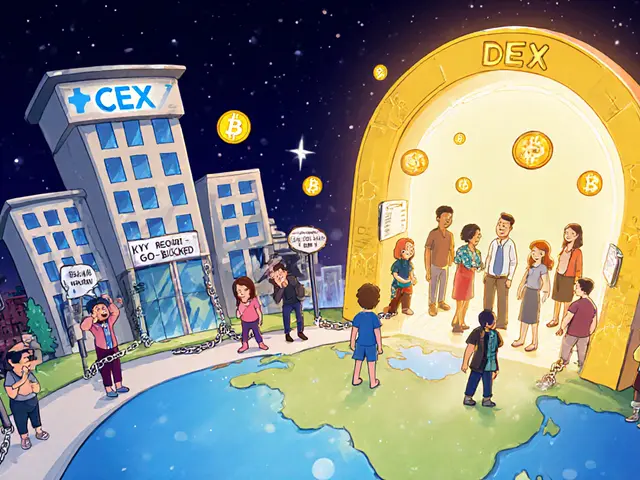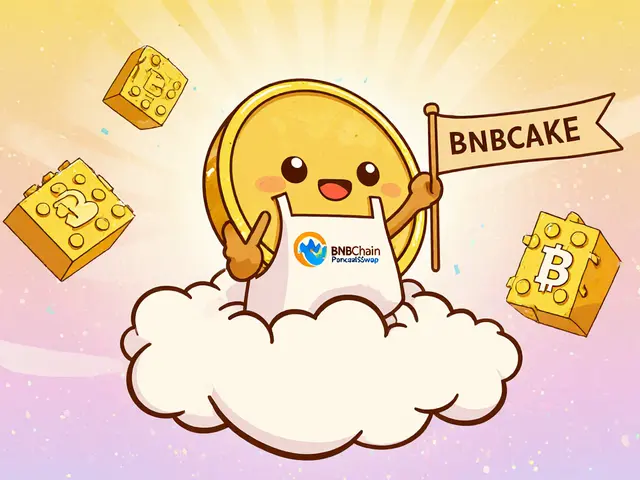ICE Poker Earnings Calculator
Calculate Your ICE Earnings
Estimate your potential earnings from playing ICE Poker based on your gaming habits. This tool demonstrates how the deflationary burn mechanism affects your rewards.
Total ICE Earned (before burn)
0.00
Estimated Value (USD)
$0.00
Note: The deflationary burn mechanism removes approximately 0.1% of your ICE rewards with each transaction. This means your actual earnings will be slightly lower than the displayed amount.
Ever wondered why a poker game in a virtual world needs its own cryptocurrency? Decentral Games ICE is the answer - a free‑to‑play, play‑to‑earn token that lets you win real value while you bluff and bet in the metaverse.
What is ICE?
ICE is a deflationary ERC‑20 style token that powers the ICE Poker platform. It acts as the in‑game currency, rewarding players for daily challenges, tournament entries, and even for buying cosmetic upgrades. Because it’s free‑to‑play, anyone can start earning ICE without an upfront purchase - you simply log in, play a hand, and watch your balance grow.
Why the token is deflationary
The token’s supply shrinks over time through a built‑in burn mechanism. Every time a player spends ICE on skins, tournament entry fees, or upgrades, a small percentage is permanently removed from circulation. This reduction aims to support price stability and potentially drive appreciation as the player base expands.
Blockchain foundation - Polygon
Polygon (previously Matic) hosts the ICE contract (0xc6c855ad634dcdad23e64da71ba85b8c51e5ad7c). Polygon’s layer‑2 solution gives ICE players fast confirmations and near‑zero gas fees, a crucial advantage for micro‑transactions like poker bets. Compared with Ethereum’s mainnet, Polygon can process thousands of transactions per second, keeping the gaming experience smooth.
The broader Decentral Games ecosystem
Decentral Games is the studio behind ICE. It also runs DG token, a separate governance token that lets holders vote on platform upgrades and treasury allocations. While DG deals with community decisions, ICE handles the day‑to‑day economics of gameplay.

ICE Poker features and how you earn
- Free daily tables - sign in, play a hand, and automatically receive ICE rewards.
- Weekly tournaments - entry fees are paid in ICE, and prize pools are distributed in the same token.
- Wearable skins and accessories - spend ICE to customize your avatar in the metaverse, with each purchase burning a portion of the token.
- Liquidity mining - users can stake ICE in DeFi pools on platforms like Aave or Curve to earn additional ICE on top of their gaming earnings.
This multi‑utility model keeps the token circulating within the ecosystem while constantly creating demand.
Market snapshot (October2025)
As of October32025, ICE trades around $0.00041 per token, with a market cap of roughly $92k and a circulating supply of 225.7million tokens. Trading volume spiked to $21.90 in a 24‑hour window - a 1,660% jump that reflects the token’s thin liquidity rather than massive investor interest. Major data aggregators like Holder.io list ICE as “not traded anywhere,” yet exchanges such as Kriptomat and Crypto.com provide price feeds and limited fiat on‑ramps for European users.
Comparison with other play‑to‑earn tokens
| Token | Primary Purpose | Blockchain | Circulating Supply | Market Cap (USD) | Utility in Game |
|---|---|---|---|---|---|
| ICE | Play‑to‑earn poker | Polygon | 225.7M | ≈$92k | Entry fees, skins, staking |
| DG | Governance | Polygon | ≈10M | ≈$150k | Voting, treasury rights |
| AXS | General gaming ecosystem | Ethereum | ≈149M | ≈$3B | Staking, gaming rewards |
| SLP | Axie Infinity items | Ethereum | ≈10B | ≈$400M | Item marketplace, breeding |
ICE’s niche focus on poker gives it a first‑mover advantage in that sub‑category, but its micro‑cap and limited exchange presence make it riskier than more established tokens like AXS.
Integration with Decentraland
The token’s world lives inside Decentraland, a fully‑decentralized virtual reality platform. Because ICE operates on the same Polygon layer, users can move seamlessly between a poker table and a virtual art gallery, using the same wallet to hold ICE, DG, and NFTs. This cross‑platform compatibility expands the token’s utility beyond poker, allowing holders to explore NFT marketplaces, DeFi dashboards, and other dApps without leaving the metaverse.
How to acquire and store ICE
For newcomers, the simplest route is through Kriptomat. The exchange lets you buy ICE with euros via bank transfer or credit card, then withdraw directly to any compatible Web3 wallet (Metamask, Trust Wallet, etc.). Once in your wallet, you retain full custody - the game uses meta‑transactions, so you never have to hand over private keys. If you prefer decentralized routes, ICE is also available on Uniswap V3 (Polygon) and can be swapped from MATIC or USDC.
Risks and future outlook
ICE’s success hinges on two big factors: mass adoption of metaverse gaming and the sustainability of the play‑to‑earn model. On the upside, Decentral Games continues to add new tables, seasonal tournaments, and collaborations with popular NFT creators, which could boost user numbers. On the downside, the token’s thin liquidity makes price swings dramatic; a sudden drop in activity could wipe out most of the market cap. Regulatory changes in Europe could also affect exchanges like Kriptomat, limiting fiat on‑ramps.
Quick takeaways
- ICE is the in‑game token for the first metaverse poker platform.
- Built on Polygon for cheap, fast transactions.
- Deflationary burns create upward price pressure if demand grows.
- Limited exchange listings - best accessed via Kriptomat or Polygon DEXes.
- Future value tied to Decentral Games’ ability to attract and retain players.
Frequently Asked Questions
What can I do with ICE tokens?
You can enter free or paid poker tables, buy avatar skins, upgrade accessories, stake in DeFi pools, and pay tournament entry fees. Every spend triggers a small burn, reducing total supply.
Is ICE a good investment?
ICE is high‑risk, high‑potential. Its value depends on player growth and liquidity. Treat it as speculative - only invest what you can afford to lose.
How do I store ICE safely?
Use any Ethereum‑compatible wallet (MetaMask, Trust Wallet) on the Polygon network. Keep your private key offline and enable hardware‑wallet support for extra security.
Where can I trade ICE?
Kriptomat offers fiat on‑ramps for European users. For crypto‑only swaps, use Uniswap V3 on Polygon or other DEXes that list the 0xc6c8…ad7c contract.
What is the relationship between ICE and DG?
DG is Decentral Games’ governance token - it lets holders vote on platform upgrades. ICE is purely an economic token used for playing and earning inside ICE Poker. They operate side‑by‑side but serve different purposes.




23 Comments
Kyla MacLaren
Nice tool, looks fun.
Linda Campbell
The Decentral Games ICE token represents a noteworthy evolution in play‑to‑earn ecosystems, particularly within the United States where domestic innovation must be championed. Its deflationary burn mechanism, reducing circulating supply by approximately one‑tenth of a percent per transaction, serves to enhance scarcity and potentially elevate value over time. Moreover, the integration of this token into a poker platform aligns with the growing demand for on‑chain gaming experiences. Users who engage regularly can anticipate modest yet compounding returns, provided they adhere to prudent risk management. The token’s architecture also incorporates smart‑contract safeguards to mitigate fraudulent activity, a critical feature for maintaining market integrity. From a regulatory perspective, ICE appears to comply with prevailing American guidelines, further solidifying its legitimacy. Consequently, investors seeking exposure to decentralized gaming may find ICE to be a compelling addition to their portfolios. In sum, the token’s design reflects a confluence of economic theory and practical application that merits close observation.
John Beaver
The burn rate on ICE is pretty simple – every time you move or claim tokens about 0.1% gets shredded, which slowly deflates the supply. That means the more you play, the less total ICE there is, so each token could be worth a bit more.
Just keep an eye on the transaction fees though, because they can bite into your profit if you’re cashing out a lot.
EDMOND FAILL
Looks slick, kinda reminds me of the old arcade calculators but on‑chain.
Jennifer Bursey
Indeed, the tokenomics exhibit a classic case of controlled inflationary pressure counterbalanced by strategic scarcity, which aligns with the broader trend of utility‑driven defi assets. Leveraging ICE within a high‑throughput poker engine could catalyze network effects that amplify both liquidity and user acquisition.
Maureen Ruiz-Sundstrom
Another overhyped gimmick masquerading as finance.
Kevin Duffy
Hey, at least it’s fun to try 🎉
Maybe the math isn’t perfect, but the community vibe is.
Tayla Williams
One must consider the ethical implications of encouraging gambling through decentralized platforms; such practices may erode societal values and foster addictive behaviors. It is imperative that developers embed responsible gaming safeguards within the protocol.
Brian Elliot
Your point about responsibility is well‑taken, and I would add that transparent reporting of burn statistics could further bolster user trust.
Marques Validus
When I first stumbled upon ICE Poker, I thought it was just another fad riding the wave of play‑to‑earn hype, but the deeper I dug, the more I realized how deeply woven the token’s mechanics are into the very fabric of the game. The burn function, while seemingly trivial at 0.1% per transaction, actually creates a subtle yet relentless pressure on the circulating supply that can compound over thousands of hands. This subtle deflation means that, paradoxically, frequent players are simultaneously contributing to the token’s scarcity, a dynamic that feels almost poetic. Moreover, the integration of ICE with a traditional poker interface lowers the barrier for entry, allowing seasoned gamblers and crypto newbies alike to engage without a steep learning curve. The smart contracts governing the payouts are auditable, providing a level of transparency that most centralized casinos can only dream of. Yet, the system is not without its pitfalls; transaction fees on congested networks can erode marginal gains, especially for low‑stakes players. The platform’s UI, while functional, sometimes feels like a relic of early 2020s web design, which may deter more aesthetically demanding users. On the flip side, the community incentives, such as staking rewards and leaderboard bonuses, add a layer of gamified motivation that keeps players coming back. From a financial perspective, ICE’s price volatility reflects broader market trends, but its intrinsic utility within the game offers a floor of demand that pure speculation lacks. I’ve seen players who started with a modest bankroll and, through disciplined play, managed to grow their holdings modestly, proving that the model can work in practice. Critics argue that the burn mechanism is just a marketing ploy, yet the on‑chain data shows a measurable reduction in total supply over time. In terms of security, the platform has withstood several audit cycles without major incidents, which bolsters confidence. However, regulatory uncertainty looms, particularly in jurisdictions that view gambling as a prohibited activity. All things considered, ICE Poker stands as a fascinating hybrid of gaming and decentralized finance, offering both entertainment and a modest avenue for token accumulation. Whether it will stand the test of time remains to be seen, but for now it provides a unique slice of the ever‑expanding crypto landscape.
Mitch Graci
Wow, just what we needed-another token that *burns* itself while we *play*! 🙄; I can't wait to watch my profits melt away, one tiny fraction at a time; truly revolutionary.
Jazmin Duthie
Sure, because gambling needs more crypto.
Michael Grima
Great, more hype.
Michael Bagryantsev
For newcomers, it helps to view ICE not just as a speculative asset but as a utility token that fuels gameplay. Understanding the burn rate can inform how often you should cash out versus reinvest. Also, keeping an eye on the gas fees will prevent unexpected losses. In short, a balanced approach to playing and token management can make the experience rewarding.
Maria Rita
Exactly! Treat it like a game‑plan, not just a money‑making scheme. 🎯
Jordann Vierii
The platform's ambition to blend cultural gaming experiences with DeFi is commendable, yet the execution sometimes feels like a half‑baked prototype. While the tokenomics are sound on paper, real‑world adoption hinges on smooth onboarding and clear user education. If the team can address these friction points, ICE could become a staple in the play‑to‑earn arena.
Lesley DeBow
Interesting concept.
DeAnna Greenhaw
One must acknowledge that the discourse surrounding ICE often oscillates between hyperbolic enthusiasm and dismissive cynicism; such binary framing detracts from a nuanced analysis. By invoking interdisciplinary perspectives-economics, game theory, and sociocultural studies-we may arrive at a more comprehensive understanding of its potential impact.
Luke L
Honestly, the previous comment missed the mark by overcomplicating a straightforward token model; the math is simple, the burn is minimal, and the utility is evident. Anyone claiming otherwise is either uninformed or wilfully obfuscating the facts.
Cynthia Chiang
While the idea behind ICE is promising, the platform could benefit from a more intuitive UI and clearer documentation. Small improvements in these areas would likely boost user retention.
Hari Chamlagai
Allow me to clarify: the token's burn mechanism operates on a per‑transaction basis, which mathematically translates to an exponential decay curve over large volumes. Ignoring this nuance leads to overly optimistic profit projections.
Ben Johnson
Because we needed another crypto‑poker hybrid.
Jason Clark
Indeed, the integration of ICE into poker adds a layer of on‑chain transparency, albeit with the usual caveats of volatility and transaction costs.